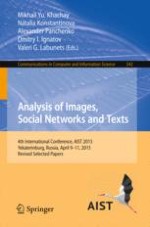2015 | Book
Analysis of Images, Social Networks and Texts
4th International Conference, AIST 2015, Yekaterinburg, Russia, April 9–11, 2015, Revised Selected Papers
Editors: Mikhail Yu. Khachay, Natalia Konstantinova, Alexander Panchenko, Dmitry Ignatov, Valeri G. Labunets
Publisher: Springer International Publishing
Book Series : Communications in Computer and Information Science
